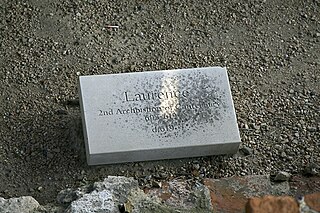 W
WThe Gregorian mission or Augustinian mission was a Christian mission sent by Pope Gregory the Great in 596 to convert Britain's Anglo-Saxons. The mission was headed by Augustine of Canterbury. By the time of the death of the last missionary in 653, the mission had established Christianity in southern Britain. Along with the Irish and Frankish missions it converted other parts of Britain as well and influenced the Hiberno-Scottish missions to Continental Europe.
 W
WThe Gregorian mission was a group of Italian monks and priests sent by Pope Gregory the Great to Britain in the late 6th and early 7th centuries to convert and Christianize the Anglo-Saxons from their native Anglo-Saxon paganism. The first group consisted of about 40 monks and priests, some of whom had been monks in Gregory's own monastery in Rome. After a long trip, during which they almost gave up and returned to Rome, they arrived in the Anglo-Saxon kingdom of Kent in 597. Gregory sent a second group of missionaries in 601 as reinforcements, along with books and relics for the newly founded churches. From Kent, the missionaries spread to the East Anglian kingdom and to the north of Britain, but after King Æthelberht of Kent's death, the mission was mostly confined to Kent. Another mission was sent to the kingdom of Northumbria when Æthelberht's daughter married King Edwin of Northumbria around 625. After Edwin's death in 633, a pagan backlash against Christianization occurred, and the mission was again confined to Kent; most of the missionaries fled Northumbria because they feared the pagans who returned to power after Edwin's death.
 W
WAugustine of Canterbury was a Benedictine monk who became the first Archbishop of Canterbury in the year 597. He is considered the "Apostle to the English" and a founder of the English Church.
 W
WSaint Bertha or Saint Aldeberge was the queen of Kent whose influence led to the Christianization of Anglo-Saxon England. She was canonized as a saint for her role in its establishment during that period of English history.
 W
WPope Gregory I, commonly known as Saint Gregory the Great, was the bishop of Rome from 3 September 590 to his death. He is known for instigating the first recorded large-scale mission from Rome, the Gregorian Mission, to convert the then-pagan Anglo-Saxons in England to Christianity. Gregory is also well known for his writings, which were more prolific than those of any of his predecessors as pope. The epithet Saint Gregory the Dialogist has been attached to him in Eastern Christianity because of his Dialogues. English translations of Eastern texts sometimes list him as Gregory "Dialogos", or the Anglo-Latinate equivalent "Dialogus".
 W
WJustus was the fourth Archbishop of Canterbury. He was sent from Italy to England by Pope Gregory the Great, on a mission to Christianize the Anglo-Saxons from their native paganism, probably arriving with the second group of missionaries despatched in 601. Justus became the first Bishop of Rochester in 604, and attended a church council in Paris in 614.
 W
WLaurence was the second Archbishop of Canterbury from about 604 to 619. He was a member of the Gregorian mission sent from Italy to England to Christianise the Anglo-Saxons from their native Anglo-Saxon paganism, although the date of his arrival is disputed. He was consecrated archbishop by his predecessor, Augustine of Canterbury, during Augustine's lifetime, to ensure continuity in the office. While archbishop, he attempted unsuccessfully to resolve differences with the native British bishops by corresponding with them about points of dispute. Laurence faced a crisis following the death of King Æthelberht of Kent, when the king's successor abandoned Christianity; he eventually reconverted. Laurence was revered as a saint after his death in 619.
 W
WLiudhard was a Frankish bishop – of where is unclear – and the chaplain of Queen Bertha of Kent, whom she brought with her from the continent upon her marriage to King Æthelberht of Kent. A short ways east of Canterbury he helped found and dedicate to Saint Martin of Tours the first Christian Saxon church in England, St Martin's, still serving as the oldest church in the English-speaking world.
 W
WSt Augustine's Abbey was a Benedictine monastery in Canterbury, Kent, England. The abbey was founded in 598 and functioned as a monastery until its dissolution in 1538 during the English Reformation. After the abbey's dissolution, it underwent dismantlement until 1848. Since 1848, part of the site has been used for educational purposes and the abbey ruins have been preserved for their historical value.
 W
WThe St Augustine Gospels is an illuminated Gospel Book which dates from the 6th century. It was made in Italy and has been in England since fairly soon after its creation; by the 16th century it had probably already been at Canterbury for almost a thousand years. It has 265 leaves measuring about 252 x 196 mm, and is not entirely complete, in particular missing pages with miniatures.